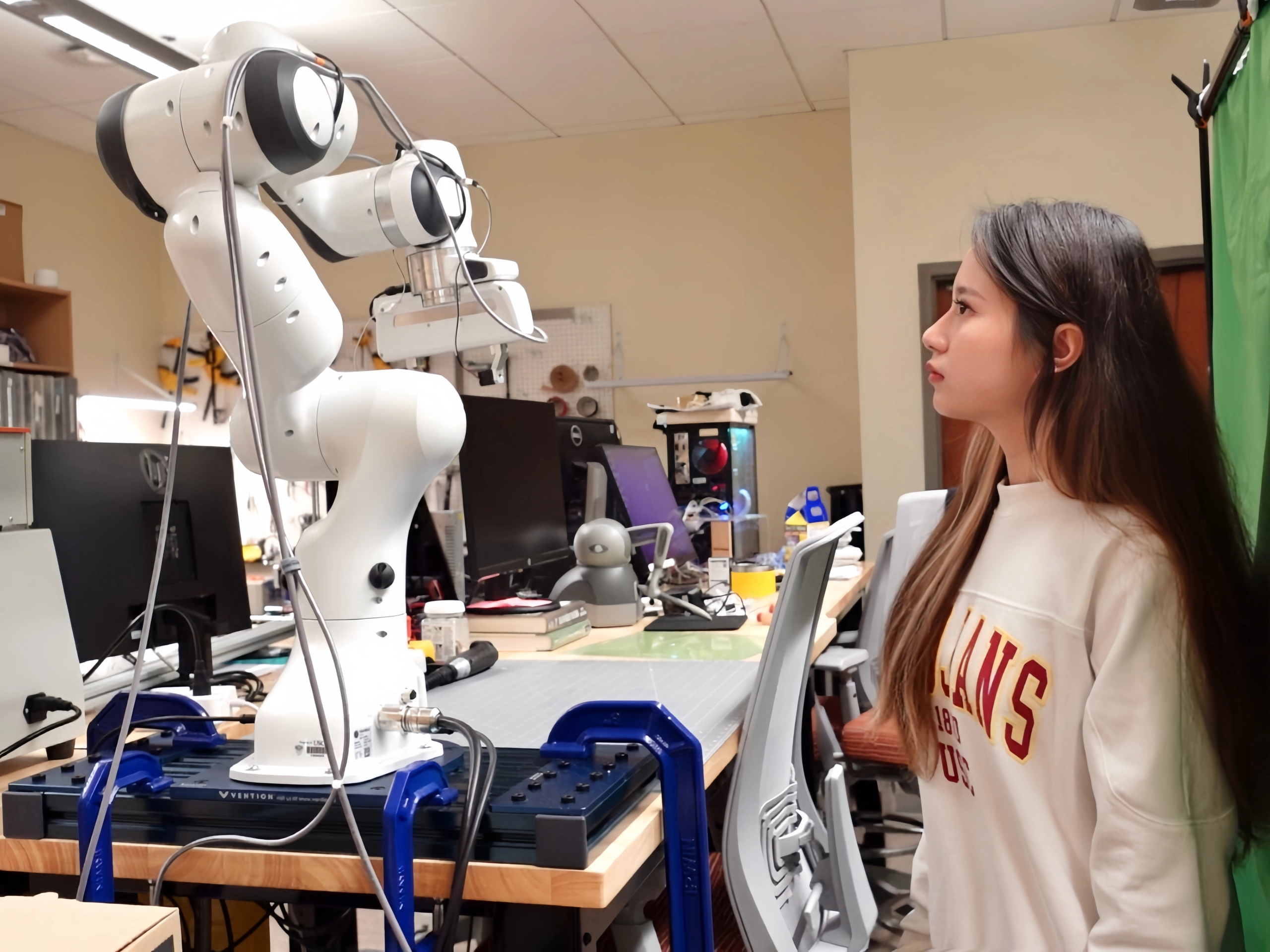Dive into the realm where touch reshapes our digital worlds, forging connections from virtual fantasies to tactile realities.
Imagine playing a video game where you can feel the grass beneath your character’s feet, or watching a movie and experiencing the gentle brush of a leaf as it falls to the ground.
This is the World Haptic technology promises — a future where digital experiences extend beyond sight and sound, engaging our sense of touch in profound ways. This curiosity has inspired a new field of research at USC, uncovering a technology that not only enhances the visual experience but also introduces a tactile dimension to digital interactions.
Heather Culbertson, an assistant professor of Computer Science and Aerospace and Mechanical Engineering and the director of the Haptics Robotics and Virtual Interaction lab at USC, defines haptics as a combination of the tactile and kinesthetic.
“Tactile is things you sense through your skin, such as vibrations, skin slip, pressure,” she said. “Kinesthetics [are] things that you sense in your muscles and joints, such as forces and torques, as well as proprioception, which is motion understanding where your body is in space.”
Currently, researchers are exploring the potential of surfing as a therapy for chronic pain. They are studying the effects of physical surfing and a virtual reality surfing experience on pain sufferers, aiming to understand how these activities can influence brain signaling and pain perception. This multidisciplinary research combines neuroscience, physical therapy and engineering to create immersive therapeutic environments that might offer new relief avenues for chronic pain sufferers.
In practice, haptic technology goes beyond the simple vibration of a phone to cover a wide range of tactile sensations that can replicate the sensations of real-world interactions in a virtual environment. The technology acts as a bridge between the digital realm and the physical experience, revolutionizing the way users interact with digital content. As researchers delve into haptic applications, from gaming to medical training, they are beginning to grasp the potential of this technology to bring every touch and every sensation a step closer to reality.
Touching the virtual from gaming to medicine
Haptic technology, a field that integrates the sense of touch with digital experiences, is revolutionizing the industry through its diverse applications. In medicine, it allows medical students to practice procedures in a virtual environment without the risks associated with real-life operations.
“There are applications within medicine in training where you have these virtual reality simulators … for training medical students in tasks such as surgery, dentistry or procedures as lumbar punctures,” Culberson said.
In addition to medicine, “a lot of startups … are looking at making haptic more immersive for gaming,” Culberson said. Haptic technology can enhance immersion, making users feel as if they are truly part of the game or film, and startups are innovating beyond traditional vibration feedback to create more immersive experiences.
The automotive industry also leverages haptic feedback to increase safety and driver awareness, with vibrating steering wheels and seats alerting drivers to potential hazards. This technology extends to remote manipulation systems in manufacturing and robotics, enhancing accuracy and control for operators handling complex tasks from a distance.
Despite substantial progress, haptics are still largely out of reach for the general public.
“They are definitely being added and integrated more frequently,” Culbertson said, “[but] they are still pricey.”
The challenges of commercial availability and accessibility underscore the balance between innovation and market readiness, highlighting the importance of scale in making haptic technology more accessible. As research continues, it’s clear that the potential of haptic technology to transform our digital interactions is immense, bridging the gap between the virtual and tangible across multiple sectors.
USC’s HaRVI Lab at the vanguard of haptic research
The HaRVI Laboratory in the Department of Computer Science at USC provides a platform for interdisciplinary exploration and research into haptic technologies. “In my lab, we’re moving beyond simple vibration to create more realistic haptic interactions,” Culbertson said.
The lab’s research encompasses multiple disciplines, integrating computer science, robotics, human-computer interaction and neuroscience. Through collaborative efforts, researchers aim to address pressing challenges in haptic technology, such as the development of wearable haptic devices and the pursuit of more realistic simulations of touch.
Xin Zhu, a doctoral candidate in the HaRVI lab, highlighted a significant challenge: the reproduction of touch. Xin is involved in developing media touch devices that can simulate various touch experiences, such as stroking or tapping, to convey emotions through digital interactions. The quest is fraught with obstacles, ranging from creating immersive environments for recipients of virtual touch to leveraging emerging technologies to capture nuanced touch experiences. The goal is to bridge the gap between digital simulations and the complex emotional nuances of human touch, a challenge that necessitates innovative solutions and interdisciplinary insights.
Culbertson pointed out another considerable challenge: the development of mechanical actuators capable of simulating touch realistically. Since touch involves mechanical interactions, replicating real-world touch sensations requires sophisticated mechanical stimulation methods. The lab’s focus on developing wearable haptic devices introduces further complications, requiring actuators that are not only effective but also lightweight, flexible and energy-efficient.
Despite these challenges, the technology remains a popular research topic. The drive for more authentic touch simulations in virtual environments has attracted the attention of major corporations. For instance, Meta’s Reality Labs began developing hand tracking and tactile feedback technology using gloves back in 2021, indicating the tech industry’s escalating interest in haptic technology. These companies are investing in research and development to surmount existing limitations, aiming to make haptic technology a fundamental component of future digital experiences.
The next horizon in haptic innovation
Zhu explained that his journey with haptic technology began with the movie “Ready Player One” (2018). “The concept of the movie is you can be put into this virtual world with the VR glasses and a whole body wearable suit so you can get into another world and physically feel the interaction within that world,” Zhu said.
Last fall, I launched a three-part video series detailing my initial experiences with haptic technology, getting into the lab to experience a simulation of beaten touch with stroking, patting, and poking. As the director and host of this project, I delved into the role of touch in virtual reality, underlining haptic technology’s transformative impact across the entertainment, healthcare, education and communication sectors.
Following the release of these videos, I conducted interviews with USC students to capture their perspectives on haptic technology and its societal implications. Many were intrigued by this nascent technology despite not being familiar with it initially. A notable reaction came from Tianyi Hou, a graduate student studying communication management who was particularly struck by the videos.
“Nowadays, virtual reality is very hot,” Hou said. “I want to know more about it. And I want to know what [the] technology [truly] is.”
Looking ahead, Culbertson predicts “a lot more expansion into the wearable formats, especially for virtual reality and gaming.” She foresees an increase in devices designed to enhance individual communication, stressing the importance of creating applications with genuine utility.
As we stand on the brink of a new era in digital interaction, haptic technology promises to redefine our connection with the virtual world, making it as tangible as our physical reality. The journey from initial curiosity to impactful research underscores a shared vision of a future where technology transcends the visual and auditory, to touch the very essence of human experience.










